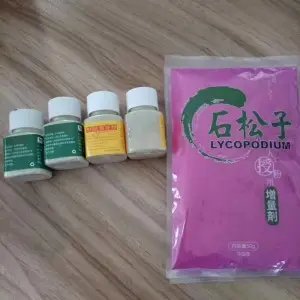Oct . 13, 2025 13:30 Back to list
Plant Pollen for Artificial Pollination | Pure, Viable Types
Stone Pine Powder as a Smarter Carrier for Pollination Workflows
I’ve spent enough seasons in orchards and greenhouses to see what works and what just… clumps. If you’re still cutting pollen with basic starch, you’ll probably want to test this: [plant pollen] solutions built around lightweight stone pine powder. The short story? Better flow, cleaner tracing, less guesswork. The long story is below.
The product in question—Manufacturer's Direct Supply Of Lightweight Stone Pine Nuts—comes from Caozhuang Development Zone, Fanzhuang Town, Zhao County, Shijiazhuang, Hebei Province. The team there started with corn starch (like most vendors), then iterated. They found stone pine powder drains and disperses more evenly with plant pollen, so pollinated vs. unpollinated blooms stop looking ambiguous. And yes, the addition of a light pink dye is deliberate: quick field visibility without overloading dosage.

Industry trend check
Mechanized pollination (dusters, blowers, even drones) is rising, while labor is scarcer and weather windows are tighter. Carriers/extenders that improve fluidity and visibility are becoming standard. Frankly, growers want fewer passes and clearer QA—color-traced blends with plant pollen are a simple win.
How it’s made (process flow)
- Materials: selected stone pine nuts, food-grade pigment for pink dye, optional anti-caking agents (compliant with local regs).
- Methods: dehulling → low-temp defatting → precision milling → multi-stage sieving → colorant blending → mild sterilization (steam/irradiation) → nitrogen flush packaging.
- Testing standards: moisture by GB/T 5009.3; microbial by GB 4789 series; bulk/tapped density per USP <616>; powder flow via Jenike shear cell (ASTM D6128).
- Service life: ≈12 months sealed at 10–25°C, RH < 60% (real-world use may vary).
- Industries: orchard fruit, greenhouse horticulture, seed production, agri-research labs.
Product specifications
| Parameter | Typical Value (≈) | Notes |
|---|---|---|
| Particle size (D90) | 120–160 μm | Sieved for even dispersion with plant pollen |
| Moisture | ≤ 8% | GB/T 5009.3 |
| Bulk density | 0.25–0.35 g/cm³ | USP <616> method |
| Angle of repose | 28–32° | Lower = better flow vs. starch |
| Color trace | Pink | Visual QA in field |
| Sterilization | Low-temp | Maintains integrity of plant pollen |
Vendor comparison (quick view)
| Vendor/Material | Flowability | Traceability | Moisture control | Typical price | Notes |
|---|---|---|---|---|---|
| Stone pine powder (Hebei) | High | Pink dye | Tight (≤8%) | Mid | Balanced for plant pollen blends |
| Corn starch filler | Medium–Low | Often none | Varies | Low | Prone to clumping in humidity |
| Imported shell powder | Medium | Optional | Good | High | Costlier; longer lead time |
Applications, advantages, customization
- Applications: hand-dusters, air-assisted sprayers, drone-mounted spreaders; mixing ratio with plant pollen typically 1:3 to 1:10 (field trials recommended).
- Advantages: smoother flow, more even deposition, clear visual auditing, and less waste compared with plain starch.
- Customization: particle size bands, pigment intensity, oil content control, sterilization mode, packaging (1 kg–25 kg).
Field snapshots (real data)
• Hebei apple blocks: pink-traced passes cut rework by ≈22% (n=6 blocks), angle of repose 30°, moisture 7.4%.
• Yunnan greenhouse tomatoes: mix 1:5 with plant pollen improved fruit set by ≈8% vs. starch carrier over two cycles.
• Shandong trial drones: 12 m/s rotor wash, no visible clumping; deposition CV improved from 0.34 to 0.26.
Anecdotally, many customers say the pink makes training seasonal crews faster. I guess it’s the small things.
Quality, certifications, and checks
Ask vendors for ISO 22000/HACCP documentation, batch COAs (moisture, microbial counts), and powder-flow data (USP <616>, ASTM D6128). For export programs, alignment with EU/US additive rules matters. And keep sealed—humidity is the silent saboteur of plant pollen blends.
- GB/T 5009.3-2016: National Food Safety Standard—Determination of Moisture in Foods.
- GB 4789 Series: National Food Safety Standards—Microbiological Examination of Food.
- ISO 22000:2018 Food safety management systems—Requirements for any organization in the food chain.
- USP <616> Bulk Density and Tapped Density of Powders (United States Pharmacopeia).
- ASTM D6128: Standard Test Method for Shear Testing of Bulk Solids Using the Jenike Shear Cell.
-
Comprehensive Guide to CE Certification Apricot Pollen Health Benefits
NewsNov.24,2025
-
CE Certification Mango Fruit Protection Bags: Enhancing Export Quality & Sustainability
NewsNov.23,2025
-
CE Certification Varieties Suitable for Collecting Apple Pollen – Ensuring Quality & Compliance in Apple Breeding
NewsNov.22,2025
-
Comprehensive Guide to CE Certification Mango Cover Bags – Quality, Standards & Trends
NewsNov.22,2025
-
What You Need to Know About CE Certification Peach Blossom Powder Keto
NewsNov.21,2025
-
CE Certification Pear Pollen Collection Base – Ensuring Quality & Sustainability in Global Horticulture
NewsNov.20,2025